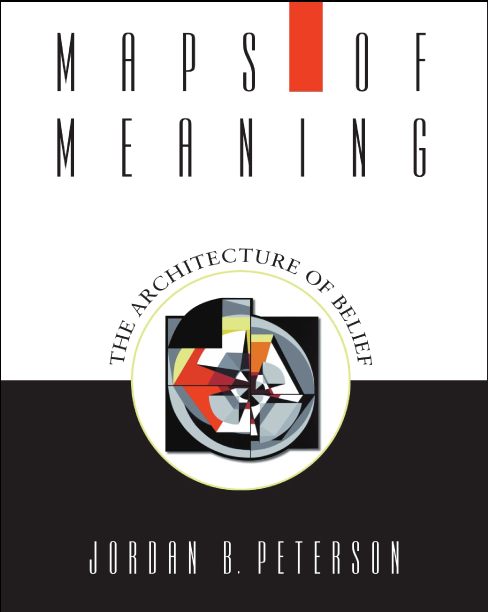
Jordan B. Peterson
Maps of Meaning
Maps of Meaning is nearly twenty years old but it contains most of the theories that JBP has been touring around the internets lately. No wonder he’s able to rant for thirty minutes without breathing—He’s been sharpening these ideas like a master swordsman for decades.
The Wisdom of Myths
If you’ve watched JBP on YouTube, many of the ideas in Maps will be familiar—order vs chaos, tyranny vs terror, the heroic individual. Maps tries to bring all of these ideas together into a Theory of Everything - a complete model of our psychological universe and a strategy for surviving in it. It’s a dense mashup of Jungian Psychology, Western mythology, and Eric Neumann’s work on the origins of consciousness that inevitably leads to a very Taoist or Buddhist image of the world.
All myths map out the eternal struggle of opposing forces within us—good and bad, fear and hope, chaos and order, and so on. The Taoist yin yang symbol captures this dynamic exquisitely in a visual formula. That same formula is buried in the myths and religions of the West, but as stories that we can no longer relate to because we try to interpret everything literally.
In the West, we’ve discarded our myths and along with them, the mythical, pre-literate mind that was capable of producing them. JBP is trying to resurrect the wisdom of that mythical universe in a way that makes sense to us today. But that’s only half the battle. We also need to embrace practices that restore some of those mythical states of mind that we’ve lost, not just the wisdom they produced. I think JBP realized this as well. Maps was written long before JBP was famous, but he’s famous now partly because he embodies the ways of being that he laid out twenty years ago in Maps.
Mythology vs Ideology
An ideology is an incomplete myth—a story that pretends to represent all the forces at play in a situation but actually ignores the uncomfortable contradictions and paradoxes that give myths their real power.
Genuine myths show us the eternal struggle between opposites in any given situation. Ideologies sound like myths, they enrapture us like myths, but they only tell one side of each of these stories. It’s this one-sidedness that makes ideology such a dangerous, de-stabalizing force. And this is true regardless of which end of the political spectrum an ideology emerges from.
In Maps, JBP is urging us to get to know our culture’s myths because he believes they might act as “an antidote to ideological gullibility.”
“Every positive force has its omnipresent and eternal “enemy”. The beneficial aspect of the “natural environment” is therefore properly viewed in light of its capacity to arbitrarily inflict suffering and death. The protective and sheltering capacity of society is therefore understood in light of its potent tendency to tyranny and elimination of necessary diversity. The heroic aspect of the individual is regarded in light of the ever-lurking figure of the adversary: arrogant, cowardly, and cruel. A story accounting for all these “constituent elements of reality” is balanced and stable, in contrast to an ideology—and/or less likely to produce an outburst of social psychopathology. But the forces that make up the world as a forum for action constantly war in opposition. How is it possible to lay a path between them, so to speak—to configure a mode of being that takes all things into account, without being destroyed in the process? A developmental account of the relationship between”the forces of the individual, society, and chaos” might aid in the comprehension of the proper interplay.”
A Footnote to Jung and Neumann
Marshall McLuhan once wrote that his book, The Gutenberg Galaxy, was just a ‘footnote’ to the work of another UofT professor, Harold Innis. It was obviously much more than that, but the debt he owed Innis was enormous. When I first started studying technology, reading McLuhan’s tribute to Innis was like finding a trail marker in a forest. I took the detour, went off and read Innis, and came back to McLuhan with a much deeper understanding of the terrain he was trying to explore.
Maps of Meaning should come with it’s own trail marker: this is in many ways a footnote to Carl Jung and Eric Neumann. That doesn’t mean it’s just a rehashing of their work. JBP spent thirteen years writing Maps—there’s an entire era of his life and thinking baked into this book. But like Innis and McLuhan, if you take the detour, and read some Jung or Neumann, you end up with a much richer understanding of the forces that JBP is trying to map out.
If you want to understand an artist, you have to dig into the art that inspired them. It took me years to figure this out with McLuhan; if you want to understand ’The medium is the message’, go read Harold Innis and Eric Havelock. If you want to hear the Beatles, listen to Elvis and Chuck Berry. If you want to understand what Kanye was trying to do to hip hop, go back and listen to Portishead. Heavy Metal is largely a cautionary tale of what happens when you don’t take this advice. Back in the 80’s, kids who had never heard of Muddy Waters tried to imitate Led Zeppelin, and we ended up with grown men in crotchless glitter pants screaming about pussy and Dungeons and Dragons. In a few years, we’re going to start seeing Heavy Metal versions of Jordan Peterson. And JBP in crotchless glitter pants isn’t going to be a pretty sight.